![]()
![]()
![]()
Use LEFT and RIGHT arrow keys to navigate between flashcards;
Use UP and DOWN arrow keys to flip the card;
H to show hint;
A reads text to speech;
38 Cards in this Set
- Front
- Back
|
What was the description of port written in 1754 by the agents for the Association of Port Wine Shippers?
|
"It should feel like liquid fire in the stomach ... it should burn like inflamed gunpowder ... should have the tint of ink ... it should be like the sugar of Brazil in sweetness and the spices of India in aromatic flavor."
|
|
|
Who is responsible for discovering port-style wines?
|
Popular belief has it that it was not the Portugese but the British who were responsible for port; however, this is not entirely accurate. We can thank the Portugese for dreaming up this most classic of fortified wines; the British merely capitalized on their original idea.
In 1678, two Englishmen were sent by a Liverpool wine merchant to Viana do Castello, north of Oporto, to learn the wine business. Vacationing up the Douro River, they were regally entertained by the Abbot of Lamego. Finding his wine "very agreeable, sweetish, and extremely smooth," they asked what made it exceptional among all others tasted on their journey. The Abbot confessed to doctoring the wine with brandy, but the Englishmen were so pleased with the result this had that they purchased the entire stock and shipped it home. |
|
|
Who were the first port houses?
|
The First Port Houses:
C. N. Kopke & Co. (1640ish) Warre & Co. (1670) Croft & Co. (1678) Quarles Harris (1680) Taylor's (1692) |
|
|
Describe the British domination of the early port trade in Portugal.
|
By the time the Methuen Treaty of 1703 gave Portugese wines preferential rates of duty in Britain, many British firms had set up business in Oporto. Firms of other nationalities - Dutch, German, and French - followed, but it was the British shippers who virtually monopolized the trade, frequently abusing their power.
|
|
|
When did British domination of port trade in Portugal come to an end? What sorts of reforms were made?
|
In 1755, the Marquis of Pombal, who had assumed almost dictatorial powers over Portugal some five years before, put a curb on their activities through the Board of Trade. The privileges enjoyed by British merchants under two 100-year-old treaties were restricted. He also established the Oporto Wine Company, endowing it with the sort of powers to which the British had been accustomed.
This infuriated the British, but their protests were to no avail and Pombal went on to instigate many worthy, if unpopular, reforms, including limiting the Douro's production area to the finest vineyards, the banning of elderberries for coloring the wine, and the outlawing of manure, which reduced yields but greatly improved quality. |
|
|
How long did it take to get port production right?
|
The production of port had not been perfected at the time of the Marquis of Pombal's sweeping reforms in 1755. Fifty years after the encounter with the Abbot of Lamego, the industry had widely accepted the practice of brandying, but the importance of when, and in what quantity, to administer the brandy had not been recognized. Ironically, the Abbot's wine was superior because he had added the brandy during, and not after, the fermentation, thus interrupting, or "muting," the process with the natural sweetness that had so attracted the two Englishmen.
|
|
|
What are the stylistic differences between the wines of British- and Portugese-owned port houses?
|
The British tend to go for bigger, darker, sweeter, fruit-driven wines and have made vintage port their particular niche, while the Portugese opt for lighter, elegant, more mellow styles, the best of which are exquisitely aged tawnies. At one time, some Portugese houses rarely even declared a vintage, since they focused on tawny. When they did, the wines were so much lighter in style that export countries often dismissed them as inferior. Although a few were indeed inferior, many were just different. Now, of course, world markets demand that if they are to survive, the Portuguese houses must declare vintages as often as British-owned houses.
|
|
|
Who tends to prefer vintage port? Tawny port?
|
It is probably more accurate to categorize the fuller, fatter vintage port as North European, not simply British, because this style is also preferred by Dutch, German, and French port houses. Tawny styles are preferred by the Portuguese.
|
|
|
Where is port made, within Portugal?
|
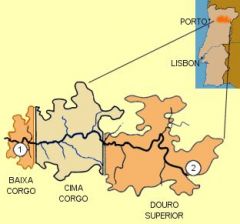
Port is made in the Baixa Corgo, Cima Corgo, and Douro Superior districts of the Douro Valley in the north of Portugal.
|
|
|
What is the climate like in the Douro Valley?
|
(p334)
The summers are dry and hot, the winters mild and wet, becoming more continental in the upper Douro Valley, where the summers are extremely hot, rainfall is high - 20.5 inches (52 centimeters) - and winters can be very cold. |
|
|
What is the aspect of the Douro Valley?
|
(p334)
Vines are planted on generally hilly land that becomes very steep in some parts. |
|
|
What is the soil like in the Douro Valley?
|
(p334)
The Douro is a patchwork of hard, sun-baked, granite, and schist soils, with the finest ports originating from the schist vineyards that dominate upriver. Because of the importance of schist to port production, Douro table wines are relegated to granite soils. |
|
|
Discuss the terracing in the Douro.
|
Terracing in the Douro is widespread to maximize the use of the land, although the current trend is to make wider terraces, thus enabling mechanization. Some of the less precipitous slopes are now cultivated in vertical rows. Steep terraces mean labor-intensive viticulture, and the hard Douro soil often requires blasting to enable planting.
|
|
|
Where does the blending and bottling of port generally take place?
|
Port wines are made and fortified in the Douro, but most are blended and bottled at lodges in Vila Nova de Gaia.
|
|
|
How many grape varieties are permitted in the production of port?
|
48
|
|
|
What are the very good black port grapes?
|
Very Good Black Port Grapes:
Bastardo Donzelinho Tinto Mourisco Tinta Cão Tinta Francisca Tinta Roriz (Touriga Francesa) (Touriga Nacional) |
|
|
What are the good black port grapes?
|
Good Black Port Grapes:
Cornifesto Malvasia Preta Mourisco de Semente Periquita Rufete Samarrinho Sousão Tinta Amarela Tinta da Barca Tinta Barroca Tinta Carvalha Touriga Brasileira |
|
|
What are the average black port grapes?
|
Average Black Port Grapes:
Alvarelhão Avesso Casculho Castela Coucieira Moreto Tinta Bairrada Tinto Martins |
|
|
What are the very good white port grapes?
|
Very Good White Port Grapes:
Donzelinho Esgana Cão Folgosão Gouveio (or Verdelho) Malvasia Fina Malvasia Rei Rabigato Viosinho |
|
|
What are the good white port grapes?
|
Good White Port Grapes:
Arinto Boal Cercial Côdega Malvasia Corada Moscatel Galego |
|
|
What are the average white port grapes?
|
Average White Port Grapes:
Branco sem Nome Fernão Pires Malvasia Parda Pedernã Praça Touriga Branca |
|
|
What are the six best port grape varieties?
|
Best Port Grape Varieties:
Touriga Nacional Tinta Cão Tinta Roriz Tinta Barroca Touriga Francesa Tinta Amarela |
|
|
Discuss the Touriga Nacional grape.
|
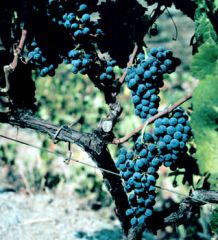
Touriga Nacional:
Almost universally agreed to be the very best of all port grapes, this has tiny berries and produces pitch-black wine with intense aromatic properties, great extract, and high tannin content. It prefers hotter situations, but is a poor pollinator and does not yield a large crop. Cloning is underway to increase production by 15% and sugar content by 10%, the most successful clone so far being R110. |
|
|
Discuss the Tinta Cão grape. What does it add to a blend?
|
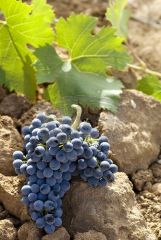
Tinta Cão:
This variety can add finesse and complexity to a blend, but it enjoys a cooler environment and requires training on wires to produce a decent crop. Since traditional cultivation methods make it a poor producer, growers are not overly eager to cultivate it; the grape's survival will depend upon the willingness of port shippers to maintain the variety on their large, managed estates. |
|
|
Discuss the Tinta Roriz grape. What does it provide in a blend?
|

Tinta Roriz:
Not really a member of the Tinta family, this grape is sometimes simply called the Roriz. It is, in fact, the well-known Spanish variety, Tempranillo, the mainstay of Rioja. In the Douro it likes heat and fares best on the sunniest front rows of terraces cut into south- or west-facing slopes. Its dark grapes have thick skins, high sugar content, and low acidity, providing great color, tannin, and succulence in a blend. Some believe this to be better than the Touriga Nacional. |
|
|
Discuss the Tinta Barroca grape.
|
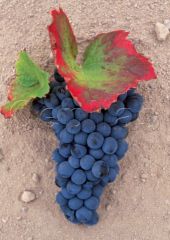
Tinta Barroca:
The wine produced by this grape variety is quite precocious and is therefore useful in younger-drinking ports, or to dilute wines that are too tannic and distinctive. Like Tinta Cão, this grape variety prefers cooler situations and particularly enjoys north-facing slopes. |
|
|
Discuss the Touriga Francesa grape. What does it give to a blend?
|
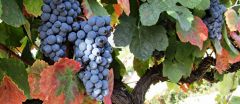
Touriga Francesa:
A member of the Touriga family, this grape has no connection with the similarly named Tinta Francisca, a member of the Tinta family. According to Bruce Guimaraens of Fonseca and Taylor's, this high-quality variety is useful for "filling in the gaps" in vineyards between those areas occupied by vines that like either hot or cool situations. It gives fruit and aroma to a blend. |
|
|
Discuss the Tinta Amarela grape. How productive is it? What is it susceptible to? Where does it perform best?
|
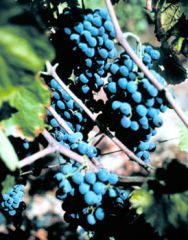
Tinta Amarela:
This grape variety is dark-colored and very productive. Its importance has been on the increase in recent years. As this high-quality vine is susceptible to rot, it performs best in the hottest, driest areas. |
|
|
How many quintas are there in the Douro Valley?
|
There are approximately 80,000 individual vineyards or quintas owned by 29,620 growers.
|
|
|
How does the quinta classification of the Douro Valley work?
|
Each vineyard is classified according to a points system allocated for the categories listed below. The better the classification, the higher official price a vineyard receives for its grapes and the greater its permitted production.
Location (-50 to +600) Aspect (1,000 to +250) Altitude; lowest is best (-900 to +150) Gradient; steepest is best (-100 to +100) Soil (-350 to+100) Schist (up to +100) Granite (down to -350) Mixture (down to -150) Microclimate; sheltered is best (up to +60) Vine varieties; official classification (-300 to +150) Age of vines; oldest is best (up to +60) Vine density; lowest is best (-50 to +50) Productivity; lowest is best (-900 to +120) Vineyard maintenance (-500 to +100) (Total Range: -3,150 to +1,490) Class A (1,200 points or more) Class B (1,001-1,199 points) Class C (801-1,000 points) Class D (601-800 points) Class E (400-600 points) Class F (400 points or below) |
|
|
How are port grapes traditionally pressed?
|
If any wine is perceived as having been "trodden," then it is port. This is perhaps because the pressing and winemaking traditionally takes place in the vineyards where, until relatively recently, affairs were conducted on farms in a rather rustic style. Today, few ports are trodden, although several houses have showpiece "lagars" - troughs used for crushing grapes - for tourists.
|
|
|
What is an "autovinificator"?
|
Many port houses have "autovinificators" - rather antiquated devices that rely on the build-up of carbonic gas pressure given off during fermentation to force the juice up and over the manta (cap) of grape skins. The object is to extract the maximum amount of coloring matter from the skins, because so much is lost by fortification. It is possible also to achieve this using special vats and several have been installed throughout the port industry.
|
|
|
Discuss the initial fermentation phase of port.
|
The initial fermentation phase of port differs little from that in the rest of the world, except that vinification temperatures are often as high as 90°F (32°C). This has no detrimental effect on port, and in fact probably accounts for its chocolaty, high-pH complexity. When a level of about 6 to 8% alcohol has been achieved, the wine is fortified, unlike sherry, for which the fermentation process is allowed to complete its natural course. Port derives its sweetness from unfermented sugars, whereas sweet sherries are totally dry wines to which a syrupy concentrate is added.
|
|
|
How is the timing of the addition of brandy to fermenting port decided?
|
The timing of the addition of the brandy is dependent upon the sugar reading, not the alcohol level. When the sweetness of the fermenting juice has dropped to approximately 90 grams per liter of sugar, the alcoholic strength will normally be between 6 and 8%, but this varies according to the richness of the juice, which in turn is dependent upon the grape variety, where it is grown, and the year.
|
|
|
What is the "brandy" used to fortify port? How strong is it? How is it produced?
|
The use of the word "brandy" is somewhat misleading. It is not, in fact, brandy, but a clear, flavorless, grape-distilled spirit of 77% alcohol, known in Portugal as "aguardente." It adds alcoholic strength to a port, but not aroma or flavor. "Aguardente" is produced either from wines made in southern Portugal or from excess production in the Douro itself. Its price and distribution to each shipper are strictly rationed.
|
|
|
How much "aguardente" is added to the wine in order to make port?
|
On average 29 gallons (110 liters) is added for every 116 gallons (440 liters) of wine, making a total of 145 gallons (550 liters) - the capacity of a Douro pipe, a specific size of cask used for shipping wine from the valley to the lodges at Vila Nova de Gaia. A drier port has a slightly longer fermentation and requires less than 26 gallons (100 liters) of "aguardente," while a particularly sweet (or "geropiga") port is muted with as much as 36 gallons (135 liters).
|
|
|
How much brandy is enough, in the making of port?
|
If gauged correctly, the brandy which has been added to arrest the fermentation will eventually harmonize with the fruit and the natural sweetness of the wine. Our conception of balance between fruit, alcohol, and sweetness is, of course, greatly affected by what we are used to drinking. In deepest Douro a local farmer is likely to use a far higher proportion of alcohol for port he intends to drink himself than for the port he makes for export. Generally, British shippers prefer more fruit and less brandy, but all commercial shippers, British or Portuguese, would consider the domestic port of a Douro farmer to lack sufficient body to match the brandy.
|
|
|
Traditionally, where did all port have to be matured and bottled? Why?
|
Until 1986, all port had by law to be matured and bottled and Vila Nova de Gaia on the left bank of the Douro estuary opposite Oporto. At some 47 miles (75 kilometers) from the region of production, this was like insisting that all Champagne be blended, bottled, and disgorged at Le Havre. The law bestowing Vila Nova de Gaia was made in 1756 and it was ostensibly created by and for the big shippers, as it effectively prevented small growers from exporting their wine, since they could not possibly afford the expense of a lodge at Vila Nova de Gaia. By the late 18th century, most of the famous port names were already established, and this restrictive law enabled them to maintain the status quo, especially on the lucrative international markets. All this has changed, and though most ports still come from the big shippers' lodges, many new ports now find their way on to the market direct from privately owned Douro quintas.
|

